Audi Q3: Rear Brake Pads, Removing and Installing
Brake Pads, Removing and Installing, Brakes 1KU
If old brake pads are being replaced with new ones, then it is necessary to check the brake rotor thickness for wear. Pay attention to the wear specifications for the brake rotor, refer to → Chapter "Brakes Technical Data".
Special tools and workshop equipment required
- Vehicle Diagnostic Tester
- Piston Resetting Tool -T10145-
Removing
- The parking brake is released.
 Note
Note
- When removing, mark brake pads that will be used again. Install in the same position, otherwise braking effect will be uneven.
- Do not disconnect the connectors from the parking brake motors.
- If the brake pads are replaced, use the Vehicle Diagnostic Tester to press back the parking brake pistons.
- Remove the affected rear wheel, refer to → Suspension, Wheels, Steering; Rep. Gr.44; Wheels and Tires.
- Connect the Vehicle Diagnostic Tester to the vehicle Data Link Connector (DLC) with the ignition switched off -arrow-.
- Turn on the ignition.
- After entering the VIN, select Guided Functions.
- Drive back the parking brake motor:

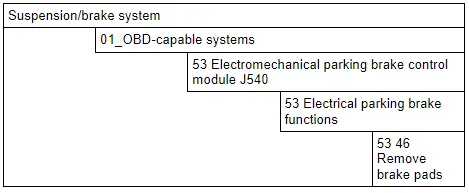
- Continue to follow the instructions in the Vehicle Diagnostic Tester display.
- Remove the brake caliper bolts while counterholding at the guide pins.
- Remove the brake caliper from the brake carrier.
 Note
Note
- When using the Vehicle Diagnostic Tester to press back the pistons, the pressure nut drives back on the spindle.
- The piston must then be completely pressed back using the Piston Resetting Tool -T10145-
 Caution
Caution
Danger of contamination and paint damage from escaping brake fluid.
- If the brake pads are worn out and unnecessary brake fluid is filled, the brake fluid may overflow, causing the pistons in the brake cylinder to be pressed back.
- Check the brake fluid level before pressing back the pistons. If there is brake fluid up to the "MAX" mark, some brake fluid will need to be extracted.
- Use the Brake Charger/Bleeder Unit -VAS5234- to extract brake fluid from brake fluid reservoir.
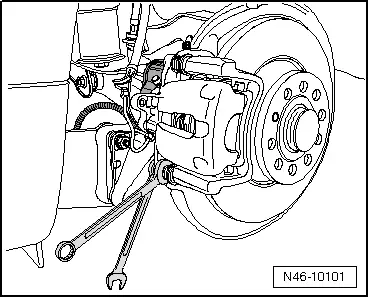
- Use the Piston Resetting Tool -T10145- to completely press back the piston.
 Caution
Caution
- Do not let the brake caliper with the brake carrier hang on the brake hose. Do not support the weight with the brake hose.
- Replace the brake hose if damaged.
- Do not actuate the brakes or the electromechanical parking brake when the brake caliper is removed.
- Hang the brake caliper on the body using a suitable wire.
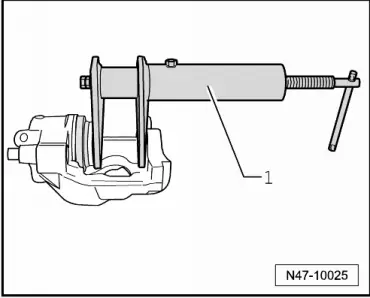
- Remove brake pads and anti-rattle springs -arrows-.
- Check the wear specification of the brake rotors, refer to → Chapter "Brakes Technical Data".
Installing
If old brake pads are being replaced with new ones, then it is necessary to check the brake rotor thickness for wear. Pay attention to the wear specifications for the brake rotor.
- Check the brake rotors for wear, refer to → Chapter "Brakes Technical Data".
Install in reverse order of removal. Note the following:
- If the brake pads are being replaced, pay attention to the brake rotor wear limit, refer to → Chapter "Brakes Technical Data".
 Note
Note
- Replace the brake caliper bolts.
- Use only mineral spirits to clean the brake caliper.
 WARNING
WARNING
Health Risk.
Do not blow out brake system with compressed air.
- Thoroughly clean the contact surfaces for brake pads on the brake carrier, remove corrosion.
- Clean the brake caliper.
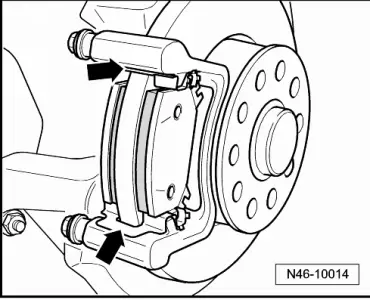
- The brake pads must sit in the brake pad retaining plates -arrows-.
- Push the brake caliper over the installed brake pads.

- Tighten the new brake caliper bolts by counterholding at the guide pins.
- Drive the parking brake motor out using the Vehicle Diagnostic Tester by following the directions on the display.
- Install the rear wheel, refer to → Suspension, Wheels, Steering; Rep. Gr.44; Wheels and Tires.
- Check brake fluid level.
 WARNING
WARNING
Risk of accident!
- Before moving vehicle, depress brake pedal several times firmly to properly seat brake pads in their normal operating position.
- Make sure the brakes are working correctly before driving the vehicle.

Brake Pads, Removing and Installing, Brakes 2EA, 2EJ, GP1
If old brake pads are being replaced with new ones, then it is necessary to check the brake rotor thickness for wear. Pay attention to the wear specifications for the brake rotor.
Special tools and workshop equipment required
- Vehicle Diagnostic Tester
- Torque Wrench 1331 5-50Nm -VAG1331-
- Piston Resetting Tool -T10145-
- Lithium grease, refer to the Parts Catalog.
Removing
- The parking brake is released.
 Note
Note
- When removing, mark brake pads that will be used again. Install in the same position, otherwise braking effect will be uneven.
- Do not disconnect the connectors from the parking brake motors.
- If the brake pads are replaced, use the Vehicle Diagnostic Tester to press back the parking brake pistons.
- Remove the affected rear wheel, refer to → Suspension, Wheels, Steering; Rep. Gr.44; Wheels and Tires.
- Connect the Vehicle diagnostic tester to the Data Link Connector (DLC) on the vehicle with the ignition switched off.
- Turn on the ignition.
- After entering the VIN, select Guided Functions.
- Drive back the parking brake motor:
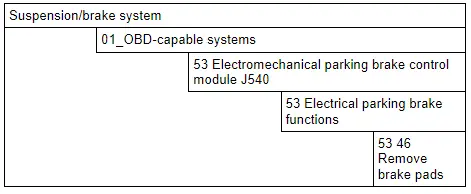
- Continue to follow the instructions in the Vehicle diagnostic tester display.
- Disconnect the brake pad wear sensor connector -1-.
- Disconnect the connector -2- to the brake pad wear sensor, release it from the bracket -arrow B- while turning it 90º at the same time -arrow A-.
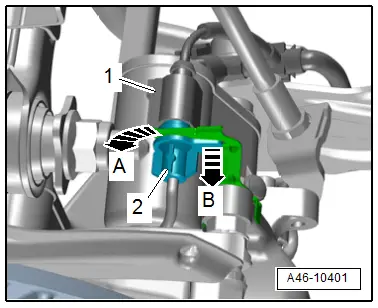
- Remove the bolts -arrows- by counterholding the guide pins -1 and 2-.
- Remove the bracket -3- and the brake caliper.
 Caution
Caution
- Do not let the brake caliper hang on the brake hose. Do not support the weight with the brake hose.
- Replace the brake hose if damaged.
- Do not actuate the brakes or the electromechanical parking brake when the brake caliper is removed.
- Hang the brake caliper on the body using a suitable wire.
- Remove the each of the brake pads to the side from the brake carrier.
Installing
If old brake pads are being replaced with new ones, then it is necessary to check the brake rotor thickness for wear. Pay attention to the wear specifications for the brake rotor.
- Check the brake rotors for wear, refer to → Chapter "Brakes Technical Data".
Install in reverse order of removal. Note the following:
 Note
Note
- Use the complete repair kit when installing new brake pads.
- If the brake pads are being replaced, then it is necessary to check the respective brake rotor for wear. For brake rotor wear limit, refer to → Chapter "Brakes Technical Data".
- Always replace brake pads on both sides of the axle.
- Use only mineral spirits to clean the brake caliper.
- Check the brake piston protective caps for damage and install the complete repair kit, if necessary, refer to → Chapter "Brake Caliper Piston, Removing and Installing".
 WARNING
WARNING
Health Risk.
Do not blow out brake system with compressed air.
 Note
Note
- When using the Vehicle Diagnostic Tester to press back the pistons, the pressure nut drives back on the spindle.
- The piston must then be completely pressed back using the Piston Resetting Tool -T10145-
 Caution
Caution
Danger of contamination and paint damage from escaping brake fluid.
- If the brake pads are worn out and unnecessary brake fluid is filled, the brake fluid may overflow, causing the pistons in the brake cylinders to be pressed back.
- Check the brake fluid level before pressing back the pistons. If there is brake fluid up to the "MAX" mark, some brake fluid will need to be extracted.
- Use the Brake Charger/Bleeder Unit -VAS5234- to extract brake fluid from brake fluid reservoir.
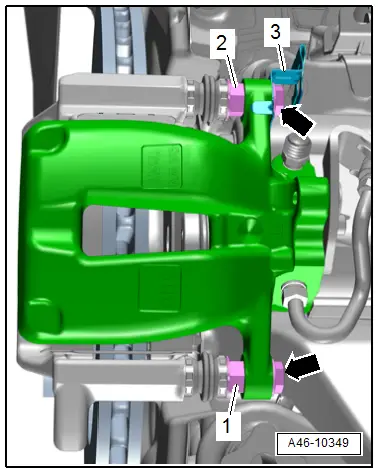
- Use the Piston Resetting Tool -T10145- to completely press back the piston.
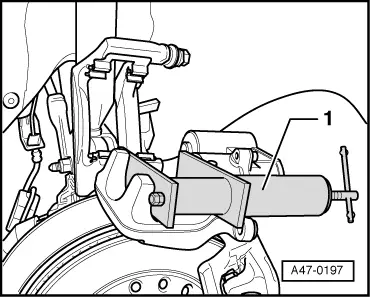
- Clean the brake caliper carrier on the brake pad spring contact surfaces -arrow- and thinly coat them with Lithium grease.

- Install the brake pad springs while paying attention to the installed position.
- Insert brake pads in brake carrier.
 Note
Note
Make sure the brake pads are seated in the brake pad springs -arrows-.
- Push the brake caliper over the installed brake pads.
 Note
Note
If the previous brake pads are being re-installed, the brake pad wear display wire must be guided through the brake caliper.
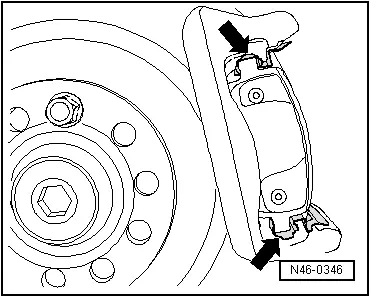
- Bring the bracket -3- into its installation position.
- Tighten the new brake caliper bolts -arrows- by counterholding the guide pins -1 and 2-.
 Note
Note
- Make sure that the electrical wire and brake hose are routed correctly.
- Make sure the brake hose is not blocked, bent or rubbing against the vehicle.
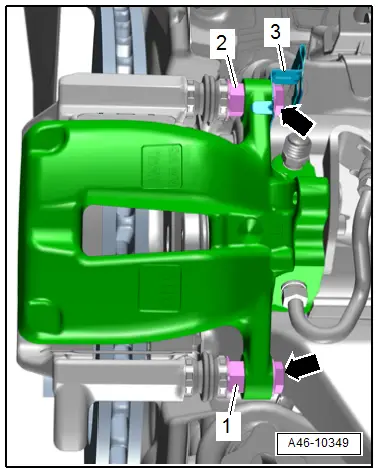
- Bring the connector -4- into its installed position and turn in direction of the -arrow- until the tab -1- engages in the hole -3- on the bracket.
- Assemble connector -2-.
- Install the rear wheel, refer to → Suspension, Wheels, Steering; Rep. Gr.44; Wheels and Tires.
- Depress brake pedal firmly several times with vehicle stationary so that the brake piston reaches its operating position.
- Drive the parking brake motor out using the Vehicle diagnostic tester by following the directions on the display.
 WARNING
WARNING
Risk of accident!
- Before moving vehicle, depress brake pedal several times firmly to properly seat brake pads in their normal operating position.
- Make sure the brakes are working correctly before driving the vehicle.


